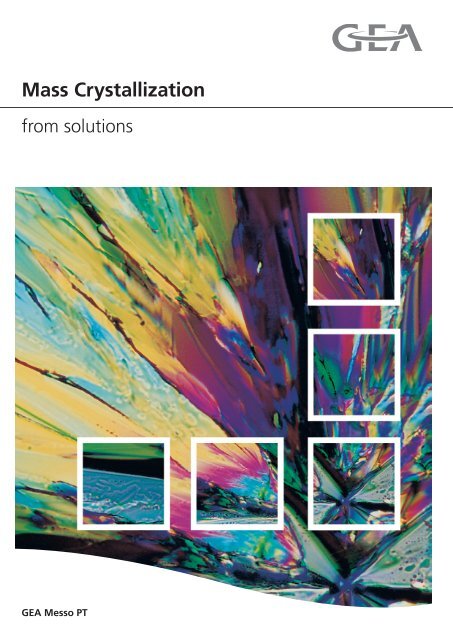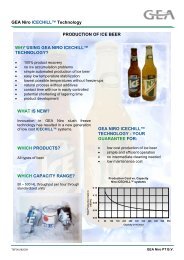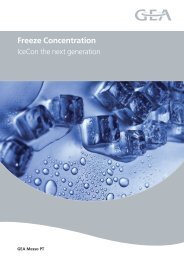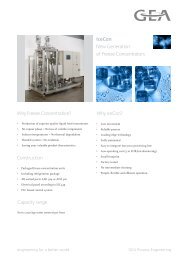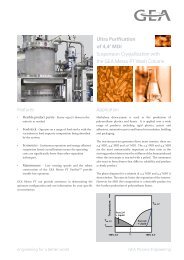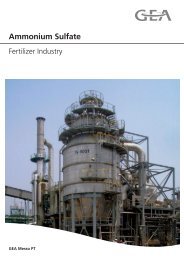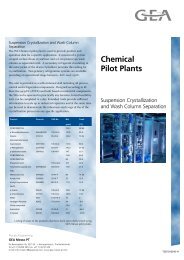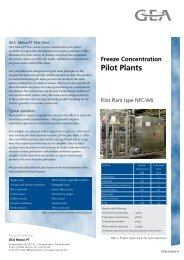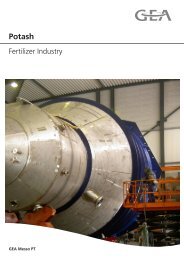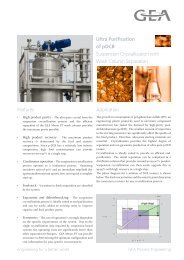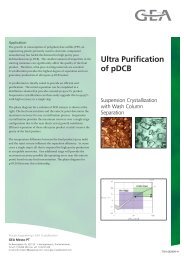Mass Crystallization - GEA Messo PT
Mass Crystallization - GEA Messo PT
Mass Crystallization - GEA Messo PT
Create successful ePaper yourself
Turn your PDF publications into a flip-book with our unique Google optimized e-Paper software.
<strong>Mass</strong> <strong>Crystallization</strong><br />
from solutions<br />
<strong>GEA</strong> <strong>Messo</strong> <strong>PT</strong>
Range of Products<br />
Individual plants for the<br />
chemical, pharmaceutical and<br />
food processing industries<br />
<strong>Crystallization</strong> and evaporation<br />
technologies for the chemical,<br />
pharmaceutical and food<br />
processing industries<br />
Plants for environmental<br />
protection<br />
(Unit operation, evaporation,<br />
crystallization, thermocompression)<br />
◊ <strong>Crystallization</strong> plants<br />
◊ Evaporation plants (all<br />
concentration under significant<br />
scaling conditions)<br />
(Entire technology concepts, based<br />
on precipitation, evaporation,<br />
crystallization)<br />
◊ Common salt production plants<br />
◊ Reaction crystallization plants for<br />
several base/acid reactions<br />
(Based on precipitation, evaporation,<br />
crystallization)<br />
◊ Pickling bath liquor recycling<br />
plants<br />
◊ Landfill leachates concentration<br />
plants<br />
◊ Industrial waste water ZLD plants<br />
◊ Treatment plants for slags from the<br />
secondary aluminum industries<br />
2
Content<br />
<strong>Messo</strong> in the field of crystallization 4<br />
<strong>Crystallization</strong> in history and presence 5<br />
<strong>Crystallization</strong> in theory and practice 6<br />
Types of crystallizers 10<br />
Forced circulation crystallizer<br />
Turbulence (DTB) crystallizer<br />
OSLO crystallizer<br />
Peripheral components<br />
Application examples 13<br />
Surface cooling crystallization<br />
Vacuum cooling crystallization<br />
Evaporative crystallization<br />
Modern applications 16<br />
Flue gas desulfurization (FGD)<br />
Recovery of caffeine<br />
Salt from secondary aluminum slag<br />
Ammonium sulfate from the caprolactam process<br />
Research and development services 18<br />
Product experience 19<br />
3
<strong>Messo</strong>, synonym for crystallization<br />
Crystals of citric acid in polarized light<br />
<strong>GEA</strong> <strong>Messo</strong> <strong>PT</strong> is well established as<br />
globally recognized technology supplier<br />
and plant constructor in the field of<br />
solution – and melt crystallization and<br />
related concentration technologies with<br />
focus on business activities to a selected<br />
range of industrial applications.<br />
<strong>GEA</strong> <strong>Messo</strong> <strong>PT</strong> has been established as a<br />
merge of the German based <strong>GEA</strong> <strong>Messo</strong><br />
GmbH and the Netherlands based <strong>GEA</strong><br />
Niro <strong>PT</strong> B.V. into one operational entity.<br />
The newly formed company combines<br />
the two technology centers for solution<br />
crystallization (MESSO) and melt<br />
crystallization/freeze concentration<br />
(NIRO <strong>PT</strong>) allowing to use all crossfertilizing<br />
synergies between solution<br />
and melt crystallization. At the same<br />
time, our customers profit from<br />
a better support out of larger and<br />
consolidated departments in sales,<br />
project management, services and<br />
administration. Experience counts<br />
for a lot in the implementation of<br />
crystallization systems and our<br />
combined track record makes <strong>GEA</strong><br />
<strong>Messo</strong> <strong>PT</strong> the supplier of choice for<br />
many of our customers.<br />
IN THE FIELD OF MASS<br />
CRYSTALLIZATION FROM<br />
SOLUTIONS, MESSO’S<br />
EXPERTISE encompasses all<br />
basic types of crystallizers for the<br />
crystallization from solutions, such<br />
as the forced circulation or draft-tube<br />
(MSMPR) crystallizer, the turbulence<br />
(DTB) crystallizer, and the fluidized<br />
bed (OSLO) crystallizer. MESSO is<br />
thus in a unique position to address<br />
the special needs of each of its<br />
clients, depending on the required<br />
product crystal quality and size.<br />
In addition to the center piece of a<br />
crystallization system, the crystallizer,<br />
MESSO offers its clients the supply<br />
of optimized peripheral equipment,<br />
in several levels of involvement.<br />
MESSO routinely supplies upstream<br />
and downstream components,<br />
such as the preconcentration (in<br />
multiple effect, mechanical vapour<br />
recompression, flash, and other<br />
evaporator configurations), the<br />
dewatering (thickening, filtration<br />
or centrifugation), drying, solids<br />
handling and packaging. MESSO also<br />
supplies piping and instrumentation<br />
and process control systems for its<br />
plants, installations in prefabricated<br />
and modularized sections, and turnkey<br />
installations, as required by the client.<br />
MESSO is a leader in its field through<br />
in-depth reviews of its operating<br />
installations and research and<br />
development. The Research and<br />
Development Department of MESSO<br />
is housed in a three-hundred-square<br />
meter facility, equipped with test units<br />
that simulate batch and continuous<br />
operation of all basic types and<br />
configurations of crystallizers. It has<br />
in-house analytical capabilities for<br />
direct determination of concentration,<br />
supersaturation, and other physical<br />
properties of the subject process<br />
liquors. Not only the design of<br />
crystallizers but the development of<br />
optimized separation processes for our<br />
clients’ needs is in the focus of MESSO<br />
chemists and engineers.<br />
In order that its know-how is<br />
continually enriched with new<br />
developments in the field of<br />
crystallization, MESSO has established<br />
the close cooperation of several leading<br />
European Universities’ Research Centers<br />
for information exchange. MESSO<br />
engineers share their wealth of practical<br />
experience with the international<br />
chemical engineering community<br />
through presentations during scientific<br />
symposia, publications of pertinent<br />
articles and the arrangement of national<br />
and international crystallization<br />
seminars. MESSO contributions have<br />
been included in several technical<br />
handbooks and the well-known<br />
Ullmanns’ Technical Encyclopedia.<br />
This state of experience, broad technical<br />
background, updated skills and in-depth<br />
research are brought to bear on each<br />
and every project MESSO handles.<br />
The results are tailor-made solutions<br />
that combine optimal investment with<br />
plant functionality, reliability, modern<br />
technology, safety, and respect for<br />
the environment. MESSO engineers<br />
always look for the most feasible plant<br />
configuration which – at the end – is<br />
also the cheapest investment.<br />
A large part of MESSO’s business comes<br />
from repeat clients; this is the best<br />
testimony for the quality of our work,<br />
the commitment of our engineers, and<br />
the performance of our equipment.<br />
4
<strong>Crystallization</strong> in history and presence<br />
In antiquity, settlements developed<br />
around, and exploited sites where salt<br />
was easily available, whether as<br />
rock, brine, or derived from solar<br />
evaporation. For example, salt was<br />
produced in the Pharaonic Egypt at<br />
the Nile Delta; similarly, the Romans<br />
recovered salt at Ostia seacoast (near<br />
Rome) and the same happened all over<br />
the world (e.g. in China). These and<br />
many other production sites prove that<br />
crystallization from solution is one of<br />
the oldest unit operations practiced by<br />
humankind.<br />
While crystallization in solar ponds is<br />
still in regions with plentiful sunshine,<br />
its low production rate and mediocre<br />
product purity prevents this technology<br />
to be used generally. As the world<br />
developed through industrial age,<br />
the demand for crystalline chemicals<br />
increased in variety, quantity, and<br />
quality. This led to the birth of<br />
crystallization technology that aimed at<br />
improving the methods and equipment<br />
used in crystallization operations.<br />
Modern crystallizers can boast specific<br />
production rates that are several orders<br />
of magnitude higher than solar ponds,<br />
have low manpower requirements, and<br />
low production costs.<br />
The specific requirements of a<br />
crystallizer can vary widely, depending<br />
on the nature of the product, and its<br />
intended use: pharmaceutical and<br />
food products require higher purity,<br />
for example, while fertilizers need<br />
larger crystal size; the crystal size and<br />
final moisture are not as important in<br />
crystallization systems which produce<br />
an intermediate compound. There are<br />
cases where the real product of the<br />
crystallizer is the solvent: crystallization<br />
is used to separate from the solvent<br />
the compounds that make it impure.<br />
Further, there are cases where<br />
crystallization is used to concentrate a<br />
solution, by crystallizing and removing<br />
the solvent (freeze concentration).<br />
One quality that is present in all<br />
crystallization systems, regardless of the<br />
final use of the solvent or the crystal,<br />
is the ability to separate the crystals<br />
from the mother liquor. This ability<br />
is a function of the crystal size,<br />
and, by extension, a function of the<br />
separation equipment that can be<br />
used. Centrifugation is by far the most<br />
efficient separation method, if the<br />
average crystal size is large enough.<br />
It is therefore logical to expect that<br />
of the characteristics of a crystallizer,<br />
the crystal size it produces is of great<br />
A 16th century salt works<br />
importance. The possible crystal size<br />
of a given compound is dependent on<br />
its chemical and physical properties,<br />
and those of the solution in which it<br />
is dissolved. In parallel, the crystal<br />
size is dependent on the equipment<br />
used to crystallize it, and the method<br />
by which the equipment is operated.<br />
The crystallizer used can contribute<br />
to improving the crystal size, within<br />
physical and energy boundaries, by<br />
controlling the nucleation, the attrition,<br />
and the growth rate of crystals, and<br />
by destroying a fraction of the smaller<br />
crystals present in the crystallizer<br />
itself. Inattention of these parameters,<br />
on the other hand, can contribute to a<br />
degradation of the crystal size.<br />
5
<strong>Crystallization</strong> in theory and practice<br />
A key parameter for crystallization is<br />
the supersaturation. Supersaturation is<br />
the temporary increase of concentration<br />
of the solute in the solvent above<br />
its equilibrium, and is produced by<br />
evaporation, cooling, chemical<br />
reaction, salting out, etc. The area over<br />
the normal solubility, in which a system<br />
can be supersaturated, is also called the<br />
”metastable” region. Supersaturation<br />
is the driving force of crystallization.<br />
Proper control of supersaturation is<br />
of critical importance in achieving<br />
acceptable results. The most common<br />
crystallization operations today are<br />
those of evaporative crystallization<br />
and of indirect and direct (vacuum)<br />
cooling: In the former, crystallization<br />
occurs after some amount of solvent<br />
is removed, and this is due to the<br />
relatively ”flat” solubility of the system<br />
at hand (Fig. 1a). In the latter case, the<br />
solubility is rather steep (Fig. 1b), and<br />
supersaturation can be achieved by<br />
cooling easily.<br />
1. <strong>Crystallization</strong> processes, shown in equilibrium (solubility) diagrams<br />
2. Kinetics of crystallization<br />
6<br />
The crystal growth rate, a parameter<br />
that measures how fast a crystal grows,<br />
is, for most systems, exponentially<br />
dependent on the supersaturation (Fig.<br />
2). However, the end result of the crystal<br />
size obtained in a crystallizer is not a<br />
matter only of the growth rate, but<br />
also of the nucleation rate (how many<br />
crystals take part in crystal growth), and<br />
the attrition rate (how easily<br />
crystals break, and how small are the<br />
broken fragments). The nucleation rate<br />
is also a function of the supersaturation,<br />
and is affected by supersaturation to a<br />
far greater degree than the growth rate<br />
(Fig. 2).<br />
As a result of these very complex<br />
relationships, the supersaturation at<br />
which a crystallizer will operate<br />
must be chosen with great care.<br />
There are two common types of<br />
nucleation mechanisms.<br />
Primary (homogeneous) nucleation<br />
occurs at the onset of crystallization,<br />
when the concentration of<br />
the solvent exceeds the metastable<br />
region, and secondary nucleation,<br />
which is caused by contacts<br />
between a crystal and another surface,<br />
and occurs within the metastable<br />
region (Fig. 2). Crystal-to crystal and<br />
crystal-to impeller contacts are the<br />
most common sources of secondary<br />
nucleation. Secondary nucleation is<br />
therefore affected by the mixing energy<br />
input to the crystallizer.<br />
Combining these characteristics of<br />
crystallization, it can be said that<br />
large singular crystals are formed<br />
at low nucleation rates. Fig. 3 is<br />
a simplification (exaggerated for<br />
purposes of illustration) of this premise,<br />
and concerns two crystallizers that have<br />
the same amount of supersaturation, 10<br />
g, from which crystals will grow. This is<br />
to demonstrate the strong influence of<br />
the nucleation rate on the mean crystal<br />
size. Due to the two different nucleation<br />
rates (5 nuclei and 40 nuclei) the result<br />
are two different crystal sizes; either 5<br />
crystals of 2 g each or 40 crystals of 250<br />
mg each.
Most crystallizers need to produce large<br />
singular crystals, because this improves<br />
crystal purity and handling<br />
characteristics, and very often the<br />
crystalline product’s marketability.<br />
To achieve a larger crystal size, it is<br />
therefore important to:<br />
◊ Control the supersaturation in<br />
the crystallizer so that it does not<br />
exceed the metastable region;<br />
◊ Choose an operating point of such<br />
supersaturation that growth rate is<br />
maximized;<br />
◊ Optimize the mixing energy<br />
input so that supersaturation<br />
is controlled, while secondary<br />
nucleation is minimized.<br />
3. Influence of nucleation on crystal size<br />
As can be seen from the above, the<br />
method and intensity of mixing in a<br />
crystallizer is very critical, as it is what<br />
most influences the supersaturation<br />
and secondary nucleation of the<br />
system. Mixing, therefore, is a basic<br />
design feature in a crystallizer unit.<br />
The instantaneous operation cycle of a<br />
typical vacuum cooling FC<br />
crystallizer, with respect to the<br />
solubility of a system, is illustrated in<br />
Fig. 4. The fresh feed at temperature<br />
and concentration represented by point<br />
(1) enters the crystallizer and is mixed<br />
with the crystallizer contents that are<br />
at concentration and temperature (3).<br />
The resultant mixture is at point (2),<br />
passes through the pump, and reaches<br />
the boiling surface of the slurry in the<br />
crystallizer. Upon boiling, the solution<br />
reaches point (4), which is well into the<br />
metastable zone. The supersaturation<br />
generated in this way is consumed by<br />
crystal growth of crystals present in the<br />
crystallizer vessel, as the supersaturated<br />
liquid is cooled adiabatically to point<br />
(3), and the cycle is completed.<br />
4. Control of tip supersaturation (vacuum cooling crystallization)<br />
7
Since it is important to maintain the<br />
peak supersaturation (point 4) within<br />
the metastable zone, the location<br />
of point (2), and more importantly, that<br />
of point (4), can be adjusted, by designing<br />
the recirculation rate in<br />
the crystallizer.<br />
If the supersaturation generated in one<br />
cycle is not completely consumed by the<br />
end of the cycle, the starting point for<br />
the next cycle will be somewhat further<br />
from the saturation curve. After some<br />
time, the whole cycle will migrate so<br />
far into or even above the metastable<br />
zone, that it will adversely affect crystal<br />
growth and nucleation. It is therefore<br />
important to provide sufficient opportunity<br />
(efficient mixing) and suitable sites<br />
(sufficient crystal surface) for the supersaturation<br />
to be consumed. Otherwise,<br />
the crystal size will suffer, and the crystallizerwill<br />
be subject to incrustations.<br />
These ideas are embodied in the two<br />
kinetic equations below. The mass<br />
deposition rate (dm/dt) resp. the consumed<br />
supersaturation per cycle time is<br />
dependent on the surface of suspended<br />
crystals (A) and on the level of supersaturation<br />
(ΔC). Secondary nucleation<br />
B 0<br />
depends on dissipated mixing energy<br />
(ε, suspension density (m) and level of<br />
supersaturation (ΔC):<br />
Crystal size is influenced by the time<br />
that the crystal stays in the crystallizer<br />
(retention time), where, under proper<br />
operating conditions, it may grow. There<br />
is, however, a competing quality in this<br />
arrangement that affects the crystal size<br />
adversely. Mechanical attrition (G a<br />
) is<br />
the rate of removal of material from<br />
a crystal (as opposed to G k<br />
, the linear,<br />
kinetic crystal growth rate), and it is<br />
dependent on the crystal retention time,<br />
the magma density, the mixing energy<br />
and the hydrodynamic design of the system.<br />
It is therefore to be expected that<br />
under certain conditions, crystal size<br />
will peak at a certain retention time, and<br />
will thereafter become smaller, as G a<br />
overpowers G k<br />
and the effective crystal<br />
growth rate is minimized.<br />
8
MESSO-type crystallizers; FC, DTB, OSLO<br />
9
Types of crystallizers<br />
All this is considered in modern types<br />
of continuous crystallizers. Crystallizers<br />
with longer retention times are<br />
operated with less specific energy<br />
input, resulting in lower nucleation<br />
rates. The impacts between crystals<br />
and the impeller pump blades are the<br />
most effective source for the nuclei<br />
production. These impacts are at least<br />
100fold more effective than crystal/wall<br />
and crystal/crystal impacts. Therefore,<br />
types of crystallizers differ mainly in<br />
design and the position of the impeller<br />
pump.<br />
Forced circulation crystallizer<br />
The forced circulation (“FC”) crystallizer<br />
(Fig. 1) is the most common type of<br />
crystallizer in the industry.<br />
The average FC crystallizer evaporates<br />
solvent, thus increasing the<br />
supersaturation in the process liquor,<br />
and causing crystallization to occur.<br />
Most conventional FC units operate<br />
under vacuum, or at slight super<br />
atmospheric pressure.<br />
The FC consists of four basic<br />
components: the crystallizer vessel,<br />
which provides most of the volume<br />
dictated by the residence time<br />
requirements, the circulating pump,<br />
which provides the mixing energy,<br />
the heat exchanger, which supplies<br />
energy to the crystallizer (in a typical<br />
evaporative crystallization operation),<br />
and the vacuum equipment, which<br />
handles the vapours generated in the<br />
crystallizer. Slurry from the crystallizer<br />
vessel is circulated, in plug flow<br />
fashion, through the heat exchanger,<br />
and returned to the crystallizer vessel<br />
again, where its supersaturation is<br />
relieved by deposition of material on<br />
the crystals present in the slurry. The<br />
supersaturation is controlled so as<br />
to avoid spontaneous nucleation, by<br />
sufficient circulation capacity.<br />
The evaporated solvent is conducted<br />
to the vacuum system, where it is<br />
condensed and removed.<br />
The FC crystallizer is used for general,<br />
simple crystallization operations, where<br />
large crystal size is not a requirement.<br />
The FC design aims to protect the<br />
crystal size from reduction from the<br />
crystallizer environment,<br />
but has no features to aggressively<br />
increase the crystal size.<br />
1. Forced circulation (FC) crystallizer 2. Turbulence (DTB) cystallizer 3. OSLO crystallizer<br />
10
Turbulence (DTB crystallizer)<br />
The MESSO turbulence with draft tube<br />
and baffle (DTB) crystallizer (Fig. 2) is<br />
the typical modern type of crystallizer<br />
in the industry. This crystallizer has<br />
been named so because it provides for<br />
two discharge streams, one of slurry<br />
that contains the product crystals, and<br />
another, that is mother liquor (saturated<br />
solvent) with a small amount of fines.<br />
The configuration of the crystallizer is<br />
such that it promotes crystal growth,<br />
and can generate crystals of a larger<br />
average size than could be achieved in<br />
an FC. Most conventional turbulence<br />
crystallizers operate under vacuum, or<br />
at slight super atmospheric pressure.<br />
The turbulence (DTB) crystallizer has<br />
been studied widely in crystallization<br />
theory, and can be modelled with<br />
accuracy. Its distinct zones of<br />
growth and clarified mother liquor<br />
make it possible to define in terms<br />
of kinetic parameters, and thus<br />
growth and nucleation rates can be<br />
determined. These features make the<br />
turbulence crystallizer very suitable<br />
to mathematical description, and thus<br />
subject to good operating control.<br />
6. Planning model of an evaporative<br />
crystallization plant (Abu Dhabi)<br />
5. Spin bath regeneration plant<br />
OSLO crystallizer)<br />
This crystallizer type (Fig. 3) originally<br />
represented the first major step in<br />
modern crystallization technology and<br />
equipment design. It was invented<br />
by F. Jeremiassen of Krystal A/S,<br />
Oslo, Norway, in 1924, and it took the<br />
name of the city in which the design<br />
originated. It is also referred to as<br />
“growth-“, “fluid-bed-”, and “Krystal-”<br />
type.<br />
As the successor of Davy Powergas’<br />
and A. W. Bamforth’s crystallization<br />
technology, MESSO owns all<br />
documentation of OSLO installations<br />
built by these two companies. This<br />
background, added to MESSO’s own<br />
extensive experience makes MESSO the<br />
premier designer of OSLO crystallizers<br />
in the world.<br />
4. Simplified flow sheet<br />
The primary advantage of the OSLO<br />
crystallizer until today is the ability<br />
to grow crystals in a fluidized bed,<br />
which is not subject to mechanical<br />
circulation methods. A crystal in an<br />
OSLO unit will grow unhindered, to<br />
the size that its residence time in the<br />
fluid bed will allow. The result is that<br />
an OSLO crystallizer will grow the<br />
largest crystals, as compared to other<br />
crystallizer types. The slurry is removed<br />
from the crystallizer’s fluidized bed and<br />
sent to typical centrifugation sections.<br />
Clear liquor may also be purged from<br />
the crystallizer’s clarification zone, if<br />
necessary. From each of these basic<br />
types of crystallizers a number of<br />
different applications are designed from<br />
MESSO engineers to fulfil the special<br />
needs of the customers.<br />
11
Peripheral components<br />
The crystallizer is the heart of a<br />
crystallization system, but there are<br />
several components, in the periphery,<br />
that need to be considered before the<br />
final product can be collected. The<br />
suspension from the crystallizer has<br />
to be separated, the crystals have to be<br />
dried and packed. The vapours have to<br />
be condensed and the noncondensables<br />
to be extracted by vacuum pumps.<br />
Fig. 4 shows a simplified flow sheet of a<br />
complete crystallization plant operated<br />
on the principle of evaporative<br />
crystallization under vacuum.<br />
Depending on process considerations<br />
(crystal size, evaporative duty, etc.) one<br />
of several types of crystallizer can be<br />
installed instead of the FC crystallizer<br />
shown, including multiple-effect units.<br />
Instead of using steam for heating (as<br />
shown), one could utilize mechanical or<br />
thermal vapour recompression.<br />
In the illustration, the vapours from<br />
the (last) crystallizer are condensed in<br />
a surface condenser; however, a mixing<br />
condenser could be chosen, instead.<br />
The suspension in the crystallizer can<br />
be withdrawn by overflow, as shown, or<br />
pumped out, using pumps with special<br />
specifications. Because suspension<br />
densities are usually between 15 to<br />
25%wt. in the crystallizer, while<br />
a centrifuge operates best at 50 to<br />
60%wt. suspension, the suspension<br />
is preconcentrated in thickeners or<br />
hydrocyclones. The underflow of the<br />
thickener or hydrocyclone is sent to the<br />
centrifuge for separation. Depending<br />
on the product CSD (and to a lesser<br />
degree on the physical properties of the<br />
suspension) there is a choice between<br />
types of centrifuges: generally, the<br />
decanter and peeler are used for smaller<br />
particles, and the screen bowl and the<br />
pusher for larger particles. In some<br />
cases of very small particle sizes or very<br />
fragile crystals, filters are used, instead<br />
of centrifuges. Filters, however, are<br />
usually not as efficient as centrifuges in<br />
separating the solvent from the crystals.<br />
The small amount of residual solvent<br />
left on the crystals after the separation<br />
step, is removed in a dryer.<br />
There are several types of dryers that<br />
are used, depending on crystal size,<br />
crystal chemistry (reactive nature,<br />
tendency to decompose, oxidize, etc.),<br />
crystal fragility, and initial solvent<br />
content. The most common types of<br />
dryers used are fluid bed (stationary or<br />
vibrating), and the flash dryer.<br />
Details from a picking bath liquor<br />
regeneration unit<br />
12<br />
Details from a picking bath liquor<br />
regeneration unit
Application examples<br />
Loop crystallizer for bisphenol A adduct<br />
The selection of equipment and the<br />
design of a crystallization operation is<br />
dependent on, and influenced by<br />
several process-specific factors. The<br />
following examples illustrate how<br />
these factors influence the choice of<br />
crystallizer type:<br />
Surface cooling crystallization<br />
Surface cooling crystallization will<br />
be selected if the solubility of the<br />
substance to be crystallized is strongly<br />
dependent on temperature, and if<br />
vacuum cooling crystallization cannot<br />
be chosen, e.g. the vapour pressure<br />
required to achieve the endpoint<br />
temperature is too low for the plant<br />
utilities, or too expensive.<br />
Melt crystallization of<br />
bisphenol A adduct<br />
Beside a number of applications for<br />
inorganic products (e.g. Glauber’s salt,<br />
carnallite) modern surface cooling<br />
suspension crystallizers are used also<br />
for melt crystallization, e.g. to crystallize<br />
bisphenol-A (BPA) phenoladduct,<br />
the prepurification step for the melt<br />
from synthesis. The eutectic point<br />
of the melt is about 39°C, and the<br />
crystallizer is operated at 45–50°C. The<br />
BPA, which is used in the production<br />
of polycarbonate, is crystallized in a<br />
surface cooled crystallizer from the<br />
melt, which consists of BPA, phenol<br />
and some impurities. The pure crystals<br />
are separated in centrifuges and<br />
washed with phenol. The design should<br />
recognize the tendency of the product<br />
to form incrustations on the heat<br />
exchange surfaces, there being the place<br />
of the highest supersaturation in the<br />
entire system. Polished surfaces and<br />
small temperature differences are some<br />
of the techniques used in modern<br />
designs to control the effects of this<br />
problem. The surface-cooled crystallizer<br />
is a simple FC unit, in which the<br />
process slurry is cooled in the tube-and<br />
shell heat exchanger in the circulating<br />
loop (loop crystallizer). Growth type<br />
crystallizers are not commonly chosen,<br />
due to the low settling rate of the<br />
crystals, which makes fines separation<br />
at the crystallizer very difficult.<br />
Vacuum cooling crystallization<br />
Vacuum cooling crystallization is<br />
usually chosen if the solubility of the<br />
substance to be crystallized is strongly<br />
dependent on temperature, and if the<br />
vapour pressure of the solvent is high<br />
enough for this application to allow<br />
the use of conventional vacuum<br />
equipment. Vacuum cooling<br />
crystallization is the preferred cooling<br />
crystallization method for continuous<br />
operation conditions, due to the fact<br />
that the supersaturation is generated<br />
by adiabatic cooling of the solvent at<br />
the liquor level. This means that the<br />
energy is removed from the crystallizer<br />
at a location that is far less prone to<br />
encrustations, and with a method that<br />
requires far less mixing energy input to<br />
the crystallizer slurry.<br />
Spin bath regeneration plant<br />
13
Potassium chloride refinery for industrial grade quality, triple-effect vacuum cooling crystallization<br />
Vacuum cooling crystallization<br />
of potassium chloride<br />
This example shows the recrystallization<br />
of potassium chloride in<br />
industrial grade from fertilizer quality.<br />
The crude KCl is dissolved at elevated<br />
temperatures in a recycled stream of<br />
mother liquor. The resulting solution,<br />
now saturated with potassium<br />
chloride, is fed to a multiple-stage,<br />
vacuum cooling crystallizer train.<br />
In order to fulfil the requirement of<br />
coarser crystals, the type selected is<br />
the DTB crystallizer. Fines dissolving<br />
is possible, by adding water to each<br />
crystallizer’s clear liquor overflow. The<br />
number of stages is optimized on the<br />
basis of maximum heat recovery (the<br />
recycled mother liquor is reheated in<br />
condensers using the vapours leaving<br />
the hotter crystallizers). Barometric<br />
(direct-contact) condensers are usually<br />
employed, so that the water content<br />
of the mother liquor is increased,<br />
and thus its dissolving capacity is<br />
improved. Steam is used (in separate<br />
heat exchangers) to heat the recycled,<br />
and diluted, mother liquor to the<br />
temperature required by the dissolver<br />
step, and the loop is closed by returning<br />
the mother liquor to the dissolver.<br />
The crystals are separated in pusher<br />
centrifuges, washed and dried. The<br />
typical crystal sizes averages are 0.8 to<br />
1.0 mm.<br />
Recovery of pickling bath<br />
effluent liquors<br />
Vacuum cooling crystallization can<br />
also be used to purify solutions, by<br />
crystallization of the solute. The<br />
pickling of mild steel sheets with<br />
sulfuric acid produces an aqueous waste<br />
stream containing ferrous sulfate and<br />
sulfuric acid. Cooling of that solution<br />
forces ferrous sulfate to crystallize as<br />
FeSO 4<br />
.7H 2<br />
O. From the viewpoint of the<br />
mother liquor composition, this is a<br />
way to purify the solution. At the same<br />
time, the seven molecules of water that<br />
is removed with the crystallized ferrous<br />
sulfate causes the reconcentration of<br />
the sulfuric acid. The solution<br />
thus treated can be recycled to the<br />
pickling bath. The vacuum cooling is<br />
achieved in a single-effect draft-tube<br />
crystallizer which is operated together<br />
with a high-vacuum generator (a<br />
steam ejector or chilled water surface<br />
condenser). This modern process may<br />
be operated for a couple of months<br />
without interruptions for washouts.<br />
Vacuum evaporators for brine concentration<br />
14
Evaporative crystallization<br />
Evaporative crystallization is usually<br />
a process that is conducted under<br />
vacuum, just like the vacuum cooling<br />
crystallization. This process is chosen<br />
when solubility of the solute is nearly<br />
independent of temperature. As<br />
in vacuum cooling crystallization,<br />
special scaling problems are not a<br />
serious problem as long as boiling on<br />
the heater surface is avoided, and<br />
the special case of inverse solubility<br />
(solubility decreases with temperature)<br />
is recognized and taken into<br />
consideration.<br />
<strong>Crystallization</strong> of sodium<br />
chloride<br />
This example shows a crystallization<br />
plant for table salt, operated with<br />
concentrated brine from a solar pond.<br />
In addition to three FC crystallizers,<br />
there is an OSLO crystallizer, used by<br />
the plant to produce a fraction of its<br />
output as coarse crystals. The plant is<br />
operated as a quadruple-effect unit.<br />
The coarse crystals from the OSLO<br />
are separated on a pusher centrifuge,<br />
whereas the salt produced in the FC<br />
crystallizers is separated on screen<br />
bowl centrifuges, after being countercurrently<br />
washed with fresh feed liquor<br />
in a washing thickener. The product<br />
crystals are dried and packed. In order<br />
to maintain the level of impurities<br />
in the system to an acceptable level,<br />
some mother liquor is removed as<br />
hydrocyclone overflow, and purged.<br />
Some plants of this type have been<br />
supplied for the production of up to<br />
2.5 t/h coarse (mean size greater than<br />
2 mm) salt and additionally 10 t/h of<br />
normal salt.<br />
Salt recovery from solar brine with OSLO crystallization<br />
15
Modern applications in environmental protection<br />
Flue gas desulfurization (FGD):<br />
scrubber effluent<br />
Concentration of scrubber effluent<br />
from FGD systems in thermal power<br />
plants has been practiced for about<br />
two decades. Plants for concentration<br />
of these waste waters to dryness are<br />
in fact evaporative crystallization<br />
units, and should not be designed as<br />
simple evaporation units. Usually, FGD<br />
concentration units are combined with<br />
pretreatment facilities, such as heavy<br />
metals precipitation, in order that it<br />
may be possible to recover a brine or a<br />
product salt pure enough to be recycled<br />
in the process. This example shows an<br />
installation for the concentrationto-dryness<br />
of the liquid effluent from a<br />
flue gas cleaning system in an industrial<br />
waste incineration facility. This plant<br />
consists of a heavy metals precipitation<br />
and a double-effect evaporative<br />
crystallization unit, with two FC<br />
crystallizers supplied to recover calcium<br />
chloride dihydrate salt. The first stage is<br />
a gypsum seeded preconcentrator, and<br />
the second stage is the calcium chloride<br />
crystallizer. The crystal product is<br />
separated on a screen bowl centrifuge,<br />
dried, packed and reused in another<br />
industrial application.<br />
Recovery of caffeine<br />
When caffeine is extracted from<br />
coffee by the supercritical carbon<br />
dioxide method, a caffeine containing<br />
waste water is produced. Evaporation,<br />
combined with a surface cooling<br />
crystallization separates this waste<br />
water into a caffeine of food grade<br />
quality, and pure distillate which can be<br />
reused for the decaffeination process.<br />
Short residence times at the higher<br />
temperatures is important in the<br />
evaporative step of this process, in order<br />
to minimize caffeine decomposition.<br />
The process encompasses active carbon<br />
treatment used to remove impurities<br />
that influence the product colour,<br />
followed by a two-stage falling film<br />
evaporator driven by process vapours<br />
compressed to a higher pressure by<br />
a single mechanical compressor. In<br />
order to minimize residence time in<br />
the evaporators, the final concentrate<br />
is produced in a separate, smaller<br />
unit. This concentrate is finally cooled<br />
to ambient temperature in a surface<br />
cooled loop crystallizer, to crystallize<br />
caffeine monohydrate. The crystals are<br />
calcined to remove the water of<br />
hydration, and packed. This caffeine<br />
product is used in the manufacture<br />
of soft drinks.<br />
Triple-effect four stage evaporation crystallization of ammonium sulphate in<br />
DTB (caprolactam process) with after-crystallization (FC)<br />
16
Salt from secondary aluminum<br />
slag<br />
When aluminum scrap is molten<br />
down, the liquefied aluminum must<br />
be protected from exposure to the<br />
atmosphere to avoid its oxidation and<br />
to absorb the impurities of the scrap.<br />
This protection is provided by a layer<br />
of molten salts, preferably a mixture<br />
of potassium and sodium chloride<br />
that floats over the aluminum. This<br />
salt remains after the recovery of the<br />
aluminum, and is cast into ingots.<br />
Because of the impurities in this<br />
solid mass, left over from the scrap<br />
aluminum residue, exposure of the<br />
ingots to humidity causes evolution of<br />
various gases.<br />
The gases evolved are poisonous and<br />
explosive, and the leachate generated<br />
from dissolution of the ingot<br />
is saturated with salts. Consequently,<br />
landfill-disposal of this waste was<br />
severely restricted in Europe during<br />
the eighties, and processes had to be<br />
developed to solve this problem in an<br />
environmentally sound way.<br />
The slag is treated mechanically to<br />
recover most of the metallic aluminum<br />
for direct recycling, and is then fed to<br />
a cascade leaching process at elevated<br />
temperatures to achieve fast degassing<br />
under controlled process conditions<br />
and to dissolve the salts. The degassing<br />
is made in the absence of atmospheric<br />
air, thus ensuring that the whole system<br />
operates above the gas mixture’s upper<br />
explosion limit. The gases evolved<br />
are purified and fed to an incinerator<br />
that allows the plant to recover the<br />
combustion energy. After degassing, the<br />
remaining residue is separated from the<br />
salt solution by filtration on a belt filter.<br />
The filter cake containing aluminum<br />
oxide is usually sent to a landfill.<br />
The solution is fed to a single-effect<br />
mechanical vapour recompression<br />
evaporative FC crystallizer, operated<br />
at about atmospheric pressure. The<br />
resulting crystallized mixed salt<br />
product is separated on a pusher<br />
centrifuge, dried and compacted into<br />
pellets which can be reused in the<br />
generation of the molten salt layer (in<br />
the beginning of this process).<br />
This crystallization method can be used<br />
for the recovery of a single salt, as well<br />
as salt mixtures.<br />
Vacuum filter for citrate extractrion<br />
Ammonium sulfate from the<br />
caprolactam process<br />
Ammonium sulfate is a by-product of<br />
the synthesis of caprolactam. Multiple<br />
effect evaporative crystallization<br />
is the well-established process to<br />
recover crystalline ammonium sulfate<br />
and market it as fertilizer. In the last<br />
few years, the fertilizer marketplace has<br />
seen an increased demand for larger<br />
crystals, and for a narrower size<br />
distribution. The example shows a<br />
triple effect evaporative crystallization<br />
plant using DTB crystallizers for the<br />
production of ammonium sulfate of an<br />
average crystal size of about 2 mm. The<br />
solution is fed counter-currently (with<br />
respect to the steam flow sequence)<br />
in order to improve crystal growth<br />
conditions by combining the<br />
highest process temperature and<br />
highest impurity concentration. The<br />
MESSO turbulence (DTB) crystallizers<br />
use bottom-entry, custom-designed<br />
axial flow internal recirculation<br />
pumps, which provide superior mixing<br />
characteristics at a lower power<br />
requirement than common agitators.<br />
The product crystal size is<br />
enhanced by fines destruction systems.<br />
Each DTB crystallizer discharges slurry<br />
to a common slurry collection<br />
tank. The slurry is then fed to pusher<br />
Vacuum cooling crystallizer for copperas<br />
centrifuges, where the crystals are<br />
washed and separated from the mother<br />
liquor. The centrifuged crystals are<br />
dried and screened, and the undersize<br />
fraction is recycled for recrystallization.<br />
The centrate is taken over by an<br />
after crystallizer (FC) to improve<br />
yield. These fine and impure crystals<br />
are concentrated by means of an<br />
hydrocyclone and the concentrated<br />
suspension is redissolved in the feed<br />
liquor. A part of the hydrocyclone<br />
overflow is taken as the liquid process<br />
purge.<br />
Salt crystallizer; modified FC-type<br />
17
Research and development services<br />
Chemical laboratory and pilot<br />
plant facilities<br />
The MESSO chemical laboratory<br />
and pilot plant facility is available to<br />
develop the basic information necessary<br />
for the design of crystallization plants<br />
as well as the most appropriate overall<br />
processes for our clients. The chemical<br />
laboratory is able to define physical<br />
properties to the crystallizer designer,<br />
such as the metastable zone width<br />
(supersaturation), desupersaturation<br />
rates, viscosity, density of a range of<br />
compositions, the system solubility,<br />
formation of mixed crystals, as well as<br />
the chemical compositions of solutions<br />
and minerals.<br />
Our research and development<br />
facility has equipment that accurately<br />
represents most types of crystallizers,<br />
and this is used as necessary to<br />
simulate the specific design envisioned<br />
for our clients. These process designs<br />
can be tested in small pilot plants<br />
brought together according to the<br />
specific process requirements, and<br />
samples can be produced for further<br />
(market) tests. In case of products<br />
that are too sensitive to be shipped<br />
to our facility, or that require special<br />
handling (due to safety or health<br />
concerns) our team may perform the<br />
necessary tests or investigations in<br />
our clients’ facilities. We are proud<br />
to have developed and optimized<br />
production processes for the chemical,<br />
pharmaceutical and food industry<br />
jointly with our customers and tailormade<br />
for the individual project.<br />
We continue to improve – for the<br />
benefit of our customers.<br />
18
Our product experience<br />
Acetylsalicylic acid & salts<br />
Adipic acid<br />
Ammonium bromide<br />
Ammonium dimolybdate<br />
Ammonium hydrogenfluoride<br />
Ammonium sulfate (also by reaction)<br />
Ammonium thiosulfate<br />
Ascorbic acid & salts<br />
Benzoic acid & salts<br />
Bisphenol A<br />
Caffeine<br />
Calcium chloride<br />
Calcium formate<br />
Calcium tartrate<br />
Carnallite<br />
Citric acid & salts<br />
Cooling Tower Blowdown<br />
Copper chloride<br />
Copper sulfate<br />
Dextrose (Glucose)<br />
Dichlorobenzene<br />
Dicyandiamide<br />
Dipentarythritol<br />
Epichloro hydrine process<br />
effluent ZLD<br />
Ferrous sulfate from process effluents<br />
Ferrous sulfate from TiO2<br />
Fumaric acid & salts<br />
Glutamic acid & salts<br />
Guanidine nitrate<br />
Hexachlorocyclohexane<br />
Isomaltulose<br />
Ketogulonic acid & salts<br />
Lactic salts<br />
Lactose<br />
Landfill Leachate<br />
Concentration & ZLD<br />
Lauryllactam<br />
Magnesium ammonium sulfate<br />
Magnesium chloride<br />
Magnesium hexafluorosilicate<br />
Magnesium sulfate<br />
Malic acid & salts<br />
Methionine<br />
Nickel acetate<br />
Nickel nitrate<br />
Pentaerythritol<br />
Potash from various sources<br />
Potassium bromide<br />
Potassium carbonate<br />
Potassium chlorate<br />
Potassium chloride<br />
Potassium dichromate<br />
Potassium hydrogencarbonate<br />
Potassium permanganate<br />
Potassium phosphate (Industrial)<br />
Potassium sulfate<br />
Potassium sulfate from<br />
Na2SO4 & KCl (conversion)<br />
Salicylic acid & salts<br />
Salt (based on sea salt<br />
respectively brines)<br />
Silver nitrate<br />
Sodium acetate<br />
Sodium ascorbate<br />
Sodium carbonate<br />
Sodium chlorate<br />
Sodium chloride from<br />
sea salt<br />
Sodium chromate (& Na2SO4)<br />
Sodium cyanide<br />
Sodium dichromate<br />
Sodium disulfite<br />
Sodium dithionite<br />
Sodium fluoride salts<br />
Sodium formate<br />
Sodium glutamate<br />
Sodium ketogulonate<br />
Sodium nitrite (waste)<br />
Sodium perborate<br />
Sodium perchlorate<br />
Sodium phosphates (industrial)<br />
Sodium salicylate<br />
Sodium sulfate<br />
Sodium tartrate<br />
Sodium thiocyanate<br />
Sorbic acid & salts<br />
Sulfanilic acid & salts<br />
Tartaric acid & salts<br />
TMP<br />
Trimellitic acid<br />
Urea<br />
Vinasse evaporation<br />
Yeast effluent processing<br />
Zinc sulfate 6-hydrate<br />
Zinc sulfate 7-hydrate<br />
19
Contact us at:<br />
www.gea-messo-pt.com<br />
Competence centers in crystallization<br />
Process Engineering<br />
<strong>GEA</strong> <strong>Messo</strong> <strong>PT</strong><br />
Germany:<br />
Friedrich-Ebert-Strasse 134<br />
47229 Duisburg<br />
Tel. + 49 2065-903 0, Fax + 49 2065-903 199<br />
info.geamesso.de @ geagroup.com<br />
The Netherlands:<br />
De Beverspijken 7b<br />
5221 EE ‘s-Hertogenbosch<br />
Tel. + 31 73 6390 390, Fax + 31 73 6312 349<br />
sales.niropt.nl @ geagroup.com<br />
03/2010 All rights reserved. Printed in the Netherlands


